The Data
As all the testing in this round up was performed with the exact same equipment, using the exact same methods I have decided to keep each radiator’s pages uncluttered by posting our testing methodology, test set-ups and equipment used in a single location. To see exactly how the tests were carried out, details of the test set ups and equipment used, please head back to the RRU Test Setup page.
Restriction Test
It’s generally agreed that radiators are one of, if not the least restrictive components in the water cooling loop. There are some exceptions however, so this must still be verified through testing:
The above photo is for referencing the restriction test bench and the 360GTS X-Flow is not loaded so please disregard the data in the picture as it does not relate to the its test results.
Here is the raw data at the tested flow rates, displaying the measured Differential Pressure across the radiator as flow rate was increased.
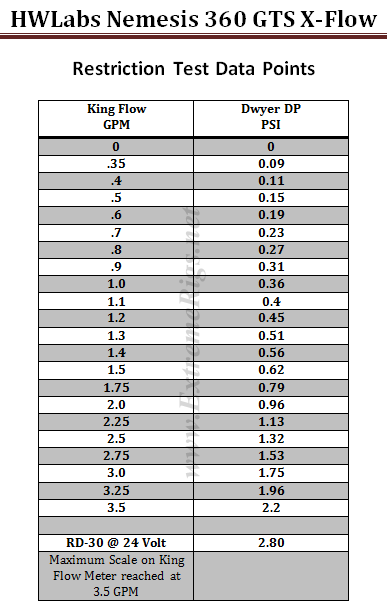 The 360 GTS X-Flow appears to be a radiator of medium restriction, unlike the NON X-Flow variant which was one of the highest we have recorded. However numbers in isolation can only tell half the story. By plotting against other components it more easily shows the whole story.
The 360 GTS X-Flow appears to be a radiator of medium restriction, unlike the NON X-Flow variant which was one of the highest we have recorded. However numbers in isolation can only tell half the story. By plotting against other components it more easily shows the whole story.
We use a HeatKiller 3.0 CPU block as the reference in these plots for two reasons. Firstly there is no chance of the plot being cluttered by curves overlapping and secondly it gives a reference point against a fairly common loop component of average restriction. As with all the radiator restriction plots I have limited the maximum flow rate displayed to 2.0 GPM as I suspect there are very few systems that operate above 2.0 GPM. For more information on how to read a restriction plot check out our guide.
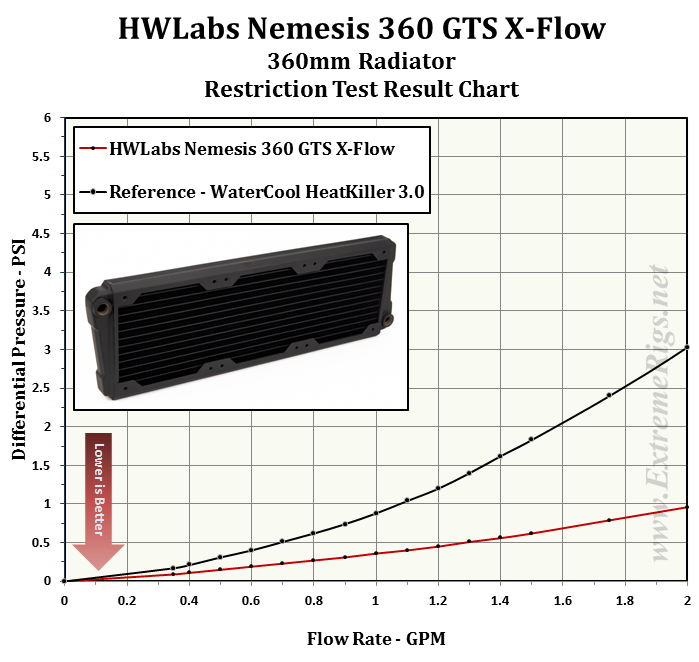 This plot indicates the 360GTS X-Flow as a low restriction loop component when compared to a CPU block of average restriction, but what about other radiators?
This plot indicates the 360GTS X-Flow as a low restriction loop component when compared to a CPU block of average restriction, but what about other radiators?
The next three plots show the restriction level relative to other slim radiators in the test group at 3 different flow rates. We consider the chosen GPM rates to represent systems which have low, medium and high flow rates.
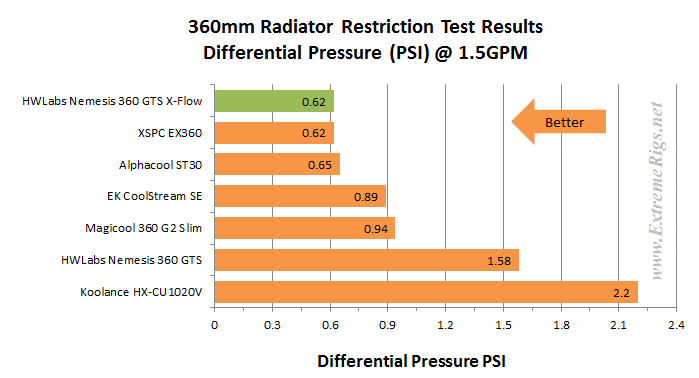
From these plots it would be fair assessment to call the 360GTS X-Flow a low restriction radiator when compared to the other slims, but before we make that conclusion let’s take a quick look at the restriction levels of our 360 rads at 1.0 gpm.
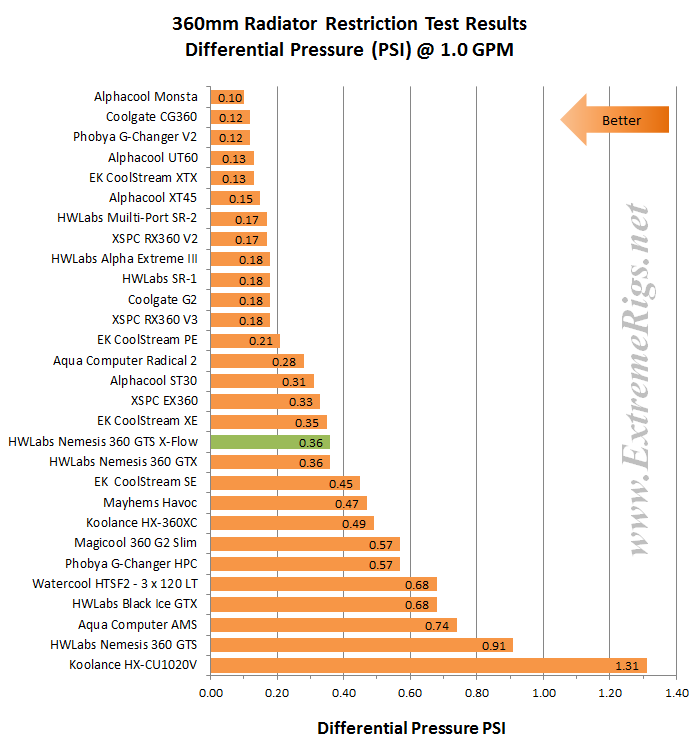 So our low restriction assessment made previously when isolated against only the slim rads has not proven to be entirely accurate. When put into context with all the 360 rads, a medium restriction radiator it is!
So our low restriction assessment made previously when isolated against only the slim rads has not proven to be entirely accurate. When put into context with all the 360 rads, a medium restriction radiator it is!
Of special interest in the above plot is the regular 360GTS having a result of 0.91 DP PSI, while the X-Flow has just 0.36. Note that the above plot is for 1.0 GPM only and the DP PSI variance should increase as the flow rate gets higher. Essentially then the XFlow is about 40% of the restriction of the non X-Flow. This is higher than we might expect – the XFlow has the same amount of tubes but uses them differently. The X-Flow has all tubes in parallel and they run only once along the radiator; the regular GTS uses half the tubes for one direction and half the tubes in the other direction. In other words, the X-Flow coolant travels though a 2x wider pipe for half the distance. Restriction should then be 25% of the regular GTS, however not all restriction comes from the tube – there will be some also from the end tanks and fittings.
Let’s take a look at the both together then:
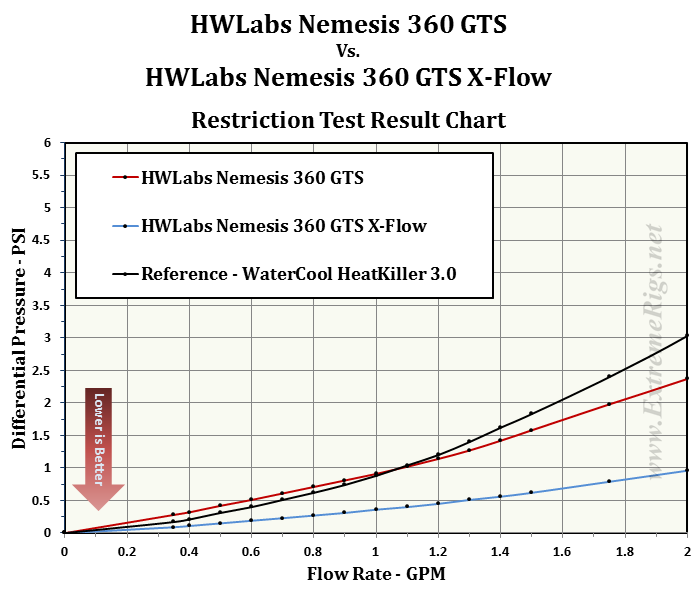 At this stage we still weren’t entirely certain whether this restriction difference would have any impact on the thermal testing as we are setting constant flow rates.
At this stage we still weren’t entirely certain whether this restriction difference would have any impact on the thermal testing as we are setting constant flow rates.
Onwards to thermal performance to find out!







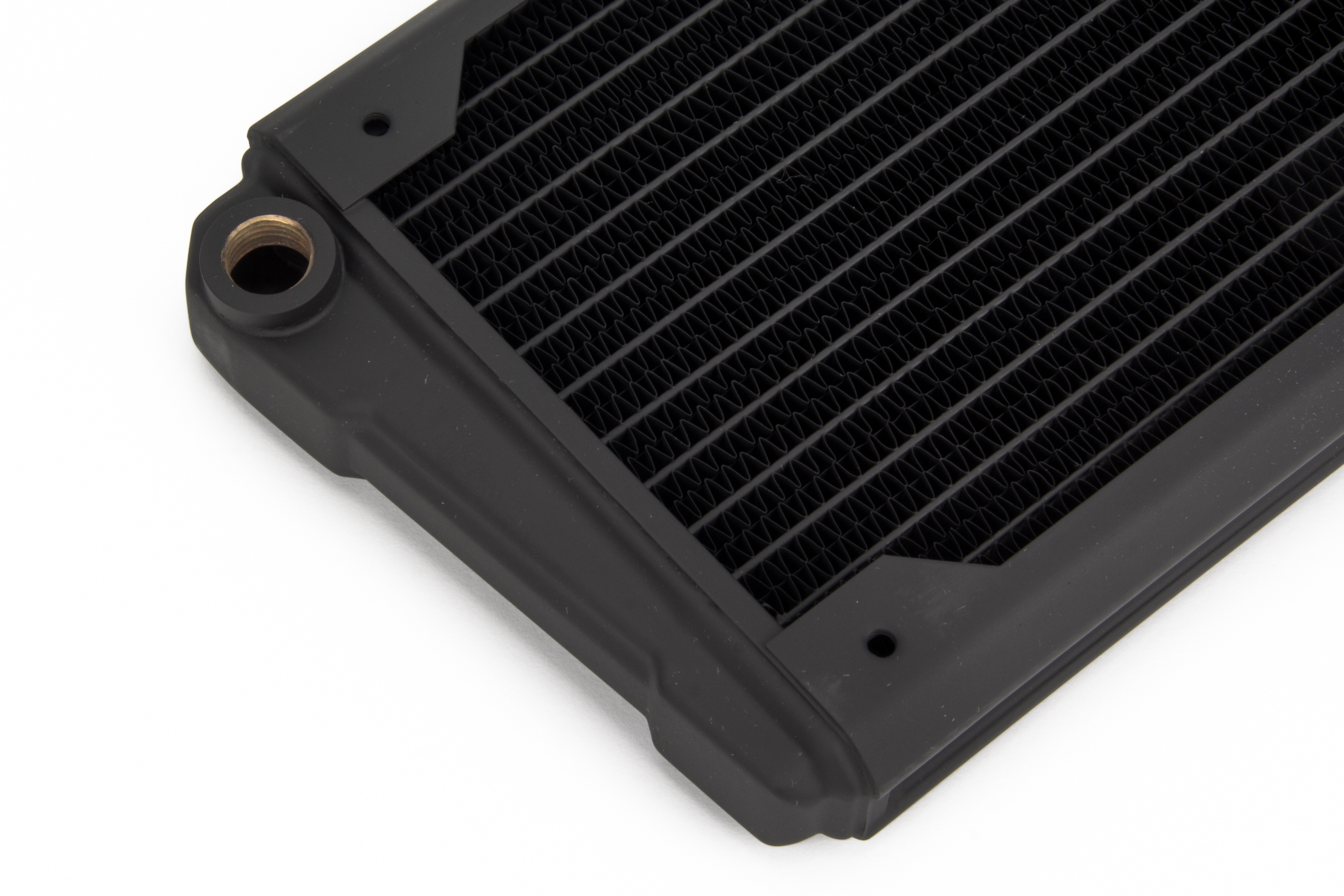
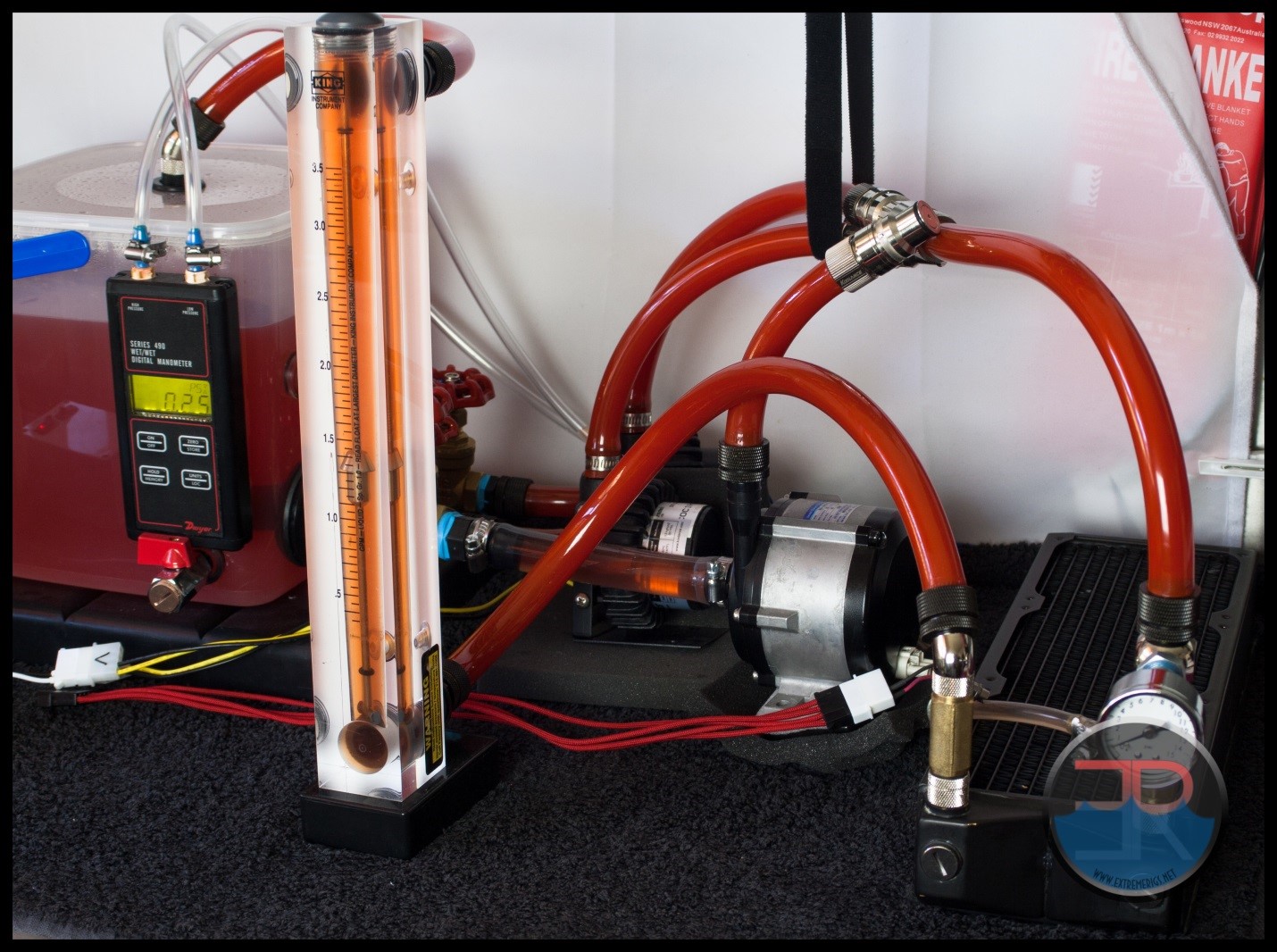
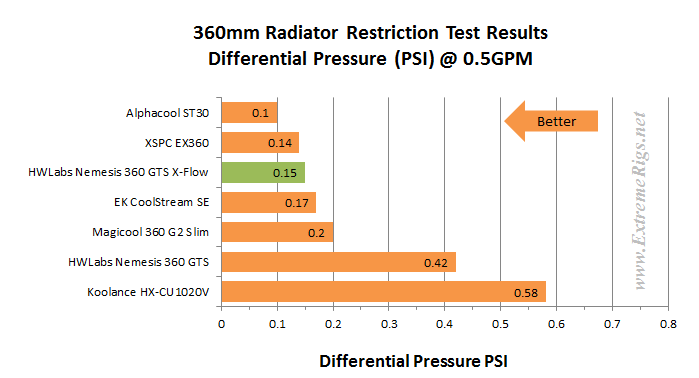
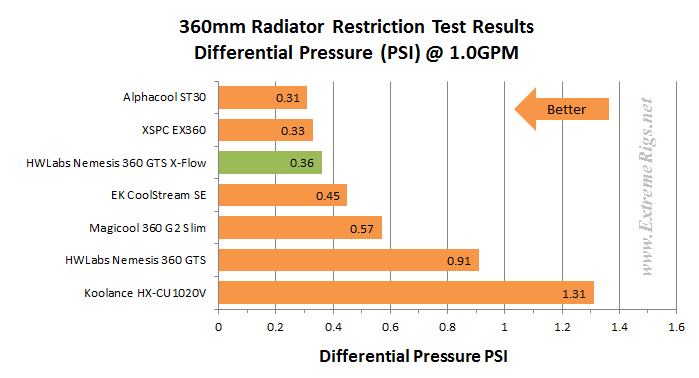



Thank you (again) for doing such a great review. I love these data driven reviews that you guys do.
I recently bought a Black Ice Nemesis 360 GTS U-Flow and Black Ice Nemesis 240 GTS U-Flow. There are in a single loop together with an EK Supremacy EVO X99 and two EK Titan X waterblocks (the GPUs in parallel). So a fairly medium / high flow restriction loop. I also have a dual D5 pump, but as I am currently in the process of tuning my rig I only have 1 pump running. The Flow rate with one D5 on maximum is absolutely fine. The D5 on maximum is also very quiet, so I am lucky there. When I get both pumps up and running I will be able to run the D5s at maybe 40% power each, I imagine, and get satisfactory flow with this set up.
Point being: given this setup I am glad that I have the extra performance of the U-Flow compared to the XFlow. As these radiators are super thin, I am less convinced at the usefulness of push/pull. If you have space for push/pull you could have gone for a 60mm thick rad surely. Also the extra length of the XFlow – as you point out – could cause problems.
Overall I think Hardware Labs radiators are terrific products. Only complaint is the 28mm screw length: I had to buy and then wait for 30mm M4 screws to be delivered to me which held up the whole build.
[…] HWLabs Nemesis 360 GTS X-Flow 360mm Radiator Review […]
Comments are closed.